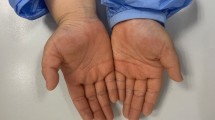Abstract
Purpose
Aeroallergens are airborne particles capable of triggering rhinitis and respiratory complications in sensitive individuals. Tree pollen is a major source of aeroallergens and can potentially induce allergic responses in a variety of ways. Thus, studying the allergenicity of urban green spaces is crucial to public health quality. Conocarpus trees have been vastly imported in recent years in Iran for reforestation projects and now have a wide distribution in southern parts of Iran, especially in Khuzestan province. Yet, these plants have not been studied adequately for their allergenic potential. This work aims to evaluate the IgE-mediated skin reactivity to Conocarpus pollen extract in patients suffering from asthma and allergic rhinitis living in southwest Iran.
Methods
Ninety consecutive patients diagnosed with asthma and allergic rhinitis were selected. Mild cases initially and moderate to severe cases after a period of treatment and follow-up underwent skin prick test (SPT) for Conocarpus pollen extract and several other aeroallergens.
Results
A skin prick test was performed for all 90 patients presenting asthma and allergic rhinitis symptoms and treated and followed in an outpatient setting. 17% had weakly positive test results for Conocarpus pollen extract. The maximum mean wheal diameter was 4 mm. For comparison, about 48% of the patient were sensitized to Russian thistle, with a maximum mean wheal size of 12 mm. Sensitization to grasses, some other trees, and indoor allergens were also measured.
Conclusion
Conocarpus trees have a low potential for inducing allergic responses in the studied population. There is no evidence that they have any role in triggering the thunderstorm asthma episodes.







Similar content being viewed by others
References
Becker AB, Abrams EM. Asthma guidelines: the Global Initiative for Asthma in relation to national guidelines. Curr Opin Allergy Clin Immunol. 2017;17(2):99–103.
Eguiluz-Gracia I, Mathioudakis AG, Bartel S, Vijverberg SJH, Fuertes E, Comberiati P, et al. The need for clean air: the way air pollution and climate change affect allergic rhinitis and asthma. Allergy. 2020;75:2170–84.
Panzner P, Vachová M, Vítovcová P, Brodská P, Vlas T. A comprehensive analysis of middle-European molecular sensitization profiles to pollen allergens. Int Arch Allergy Immunol. 2014;164:74–82.
Pawankar R, Canonica GW, Holgate Lockey Blaiss StSTRFM. The WAO white book on allergy 2013 update.. available from www.worldallergy.org/UserFiles/file/WhiteBook2-2013-v8.pdf. Accessed 6 May 2022.
Idani E, Raji H, Madadizadeh F, Cheraghian B, Shoshtari MH, Dastoorpoor M. Prevalence of asthma and other allergic conditions in adults in Khuzestan, southwest Iran, 2018. BMC Public Health. 2019;19:303.
Zhai Y, Li X, Wang T, Wang B, Li C, Zeng G. A review on airborne microorganisms in particulate matters: composition, characteristics and influence factors. Environ Int. 2018;113:74–90.
Sun X, Waller A, Yeatts KB, Thie L. Pollen concentration and asthma exacerbations in Wake County, North Carolina, 2006–2012. Sci Total Environ. 2016;544:185–91.
Mansouritorghabeh H, Jabbari-Azad F, Sankian M, Varasteh A, Farid-Hosseini R. The most common allergenic tree pollen grains in the middle east: a narrative review. Iran J Med Sci. 2019;44:87–98.
Assarehzadegan MA, Shakurnia A, Amini A. The most common aeroallergens in a tropical region in Southwestern Iran. World Allergy Organ J. 2013;6:7.
Koeser AK, Hasing G, Friedman MH, Irving R. Trees: north & central florida. Uf Institute of Food and Agricultural Sciences; 2022.
Agrawal AA, Spiller DA. Polymorphic buttonwood: effects of disturbance on resistance to herbivores in green and silver morphs of a Bahamian shrub. Am J Bot. 2004;91:1990–7.
Hassanpouraghdam MB, Ghorbani H, Esmaeilpour M, Alford MH, Strzemski M, Dresler S. Diversity and distribution patterns of endemic medicinal and aromatic plants of Iran: implications for conservation and habitat management. Int J Environ Res Public Health. 2022;19:1552.
Namjoyan F, Farasat M, Kiabi S, Ramezani Z, Mousavi H. Structural and ultra-structural analysis ofConocarpus erectuspollen grains before and after dust storms. Grana. 2020;59:226–37.
Ramezani Z, Mousavi H, Zamani M, Ghaderi F, Tahmasebi R, Movahed A, et al. Reactivity to Conocarpus tree pollen in patients with respiratory allergic diseases in the south-western part of Iran. Grana. 2022;61:140–7.
Dehdari Rad H, Assarehzadegan MA, Goudarzi G, Sorooshian A, Tahmasebi Birgani Y, Maleki H, et al. Do Conocarpus erectus airborne pollen grains exacerbate autumnal thunderstorm asthma attacks in Ahvaz, Iran? Atmos Environ. 1994;213:311–25.
Idani E, Dastoorpoor M, Goudarzi G, Haddadzadeh Shoushtari M, Raji H. Three consecutive episodes of thunderstorm asthma in Ahvaz, Iran: the possible role of conocarpus pollen. Tanaffos. 2021;20:261–7.
Haahtela T, Burbach GJ, Bachert C, Bindslev-Jensen C, Bonini S, Bousquet J, et al. Clinical relevance is associated with allergen-specific wheal size in skin prick testing. Clin Exp Allergy. 2014;44:407–16.
Acknowledgement
We gratefully acknowledge Dr. Benoit Nemmery de Bellavaux, Dr. Lieve Coorevits and Dr. Mohammad Shahrooei for preparing Conocarpus extract that we used for skin prick test.
Funding
This study is financially supported by grants from Ahvaz Jundishapur University of Medical Sciences, Ahvaz, Iran.
Author information
Authors and Affiliations
Contributions
Dr. Abbas Fayezi and Dr. Mehdi Torabizadeh participated in the selection of patients, performing the skin prick tests, and data collection. Dr. Mohammad Shahrooei prepared the extracts. Dr. Mehrangiz Chehrazi revised the manuscript regarding the botanical information. All authors took part in the study design and revision of the final manuscript.
Corresponding author
Ethics declarations
Conflict of interest
A. Fayezi, M. Shahrooei, M. Chehrazi and M. Torabizadeh declare that they have no competing interests.
Ethical standards
This study was performed in line with the principles of the Declaration of Helsinki. Approval was granted by the Ethics Committee of Golestan Hospital (No.: IR.AJUMS.HGOLESTAN.REC.1400.088). Consent to participate: Written consent was obtained from all the participants or their legal guardians.
Rights and permissions
About this article
Cite this article
Fayezi, A., Shahrooei, M., Chehrazi, M. et al. Conocarpus trees have low allergenicity potential in patients suffering from asthma and allergic rhinitis living in southwestern Iran. Allergo J Int 32, 144–150 (2023). https://doi.org/10.1007/s40629-022-00239-0
Received:
Accepted:
Published:
Issue Date:
DOI: https://doi.org/10.1007/s40629-022-00239-0




